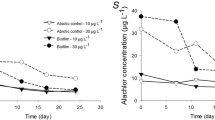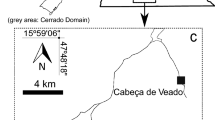Abstract
As benthic biofilms mediate essential functions in stream ecosystems (e.g., carbon flux, storage of nutrients and other substances), the element-specific regulation of the biofilm composition is of great interest. We tested whether (1) the elemental composition of biofilms is related to that of the water column and (2) there are different accumulation patterns from the dissolved phase (adsorption) and the particulate phase (incorporation of suspended matter). We analysed biomass parameters, nutrients and metals in biofilms and surface waters at 28 sites within a stream network (Bode catchment, Germany). Algal biomass in biofilms was dominated by diatoms. The P/C ratio in biofilms was positively related to total phosphorus of surface water (and to the proportion of agricultural area in the catchment) indicating phosphorus limitation of biofilms, whereas the N/C ratio was not related to nitrate levels of surface water, and neither the P/C nor the N/C ratio to the concentration of dissolved organic carbon (DOC) of surface water. Biofilms were enriched in metals compared to their concentrations in water. The metals in biofilms were positively related to the concentration of dissolved metals in surface water for iron and strontium (but not for manganese, copper, zinc, arsenic or lead) and to the concentrations of particle-associated metals of surface waters for strontium and lead. Manganese and arsenic were the metals with a negative effect on the biomasses of biofilm diatoms and cyanobacteria. Overall, we observed element-specific accumulation patterns in biofilms with selected elements being related to the water column while others were probably subject to biofilm-internal processes.








Similar content being viewed by others
References
Ancion, P.-Y., Lear, G., Dopheide, A., & Lewis, G. D. (2013). Metal concentration in stream biofilm and sediments and their potential to explain biofilm microbial community structure. Environmental Pollution, 173, 117–124.
Bärlocher, F., & Murdoch, J. H. (1989). Hyporheic biofilms—a potential food source for interstitial animals. Hydrobiologia, 184, 61–67.
Battin, T. J., Kaplan, L. A., Newbold, J. D., & Hansen, C. M. E. (2003). Contributions of microbial biofilms to ecosystem processes in stream mesocosms. Nature, 426, 439–442.
Battin, T. J., Kaplan, L. A., Findlay, S., Hopkinson, C. S., Marti, E., Packman, A. I., Newbold, J. D., & Sabater, F. (2008). Biophysical controls on organic carbon fluxes in fluvial networks. Nature Geoscience, 1, 95–100.
Bechtold, H. A., Marcarelli, A. M., Baxter, C. V., & Inouye, R. S. (2012). Effects of N, P, and organic carbon on stream biofilm nutrient limitation and uptake in a semi-arid watershed. Limnology and Oceanography, 57, 1544–1554.
Behra, R., Ruperez, W., Wagne, B., Kistler, D., Sigg, L., Navarro, E., Robinson, C. (2005). Wie wirken sich Metalle auf Algenbiofilme aus? Eawag News: Biofilme 60d: 16–18.
Burns, A., & Walker, K. F. (2000). Biofilms as food for decapods (Atyidae, Palaemonidae) in the River Murray, South Australia. Hydrobiologia, 437, 83–90.
Campbell, P. G. C., Errecalde, O., Fortin, C., Hiriart-Baer, V. P., & Vigneault, B. (2002). Metal bioavailability to phytoplankton applicability of the biotic ligand model. Comparative Biochemistry and Physiology, Part C: Toxicology & Pharmacology, 133, 189–206.
DIN EN 1484 (1997). Water analysis—guidelines for the determination of total organic carbon (TOC) and dissolved organic carbon (DOC); German version. Berlin:Beuth.
DIN EN ISO 6878 (2004). Water quality—determination of phosphorus—ammonium molybdate spectrometric method. Berlin:Beuth.
EEA (2012). CORINE land cover. European Environment Agency. Acquired from http://www.eea.europa.eu/publications/COR0-landcover/page001.html Accessed in April 2012.
EU-WFD (2000). Directive 2000/60/EC of the European Parliament and of the Council of 23 October 2000 establishing a framework for community action in the field of water policy. Official Journal of the European Communities L 327/1.
Fischer, H., Sachse, A., Steinberg, C. E. W., & Pusch, M. (2002). Differential retention and utilization of dissolved organic carbon by bacteria in river sediments. Limnology and Oceanography, 47, 1702–1711.
Flemming, H.-C. (1996). Sorption sites in biofilms. Water Science and Technology, 32, 27–33.
Flemming, H.-C., & Wingender, J. (2010). The biofilm matrix. Nature Reviews Microbiology, 8, 623–633.
Friese, K., Mages, M., Wendt-Potthoff, K., & Neu, T. R. (1997). Determination of heavy metals in biofilms from the River Elbe by total-reflection X-ray fluorescence spectrometry. Spectrochimica Acta, 52B, 1019–1025.
Guasch, H., Navarro, E., Serra, A., & Sabater, S. (2004). Phosphate limitation influences the sensitivity to copper in periphytic algae. Freshwater Biology, 49, 463–473.
Hillebrand, H., & Sommer, U. (1999). The nutrient stoichiometry of benthic microalgal growth: redfield proportions are optimal. Limnology and Oceanography, 44, 440–446.
Kamjunke, N., Büttner, O., Jäger, C. G., Marcus, H., von Tümpling, W., Halbedel, S., Norf, H., Brauns, M., Baborowski, M., Wild, R., Borchardt, D., & Weitere, M. (2013). Biogeochemical patterns in a river network along a land use gradient. Environmental Monitoring and Assessment, 185, 9221–9236.
Knauer, K., Behra, R., & Sigg, L. (1997). Effects of free Cu2+ and Zn2+ ions on growth and metal accumulation in freshwater algae. Environmental Toxicology and Chemistry, 16, 220–229.
Kröpfl, K., Vladar, P., Szabo, K., Ács, É., Borsodi, A. K., Szikora, S., Caroli, S., & Zaray, G. Y. (2006). Chemical and biological characterisation of biofilms formed on different substrata in Tisza river (Hungary). Environmental Pollution, 144, 626–631.
Lawrence, J. R., Scharf, B., Packroff, G., & Neu, T. R. (2002). Microscale evaluation of the effects of grazing by invertebrates with contrasting feeding modes on river biofilm architecture and composition. Microbial Ecology, 43, 199–207.
Le Faucheur, S., Sigg, L., & Behra, R. (2005). Phytochelatine als Metallindikatoren? Eawag News: Biofilme, 60d, 22–23.
Lehto, L. L. P., & Hill, B. H. (2013). The effect of catchment urbanization on nutrient uptake and biofilm enzyme activity in Lake Superior (USA) tributary streams. Hydrobiologia, 713, 35–51.
Mages, M. (2013). Elementbestimmungen in aquatischen Biofilmen und Zooplankton mittels Total Reflektierender Röntgenfluoreszenz Analytik (TXRF). PhD thesis, Leuphana Universität Lüneburg.
Mages, M., Ovari, M., von Tümpling, W. J., & Kröpfl, K. (2004). Biofilms as bioindicators for polluted waters? Total reflection X-ray analysis of biofilms of the Tisza river (Hungary). Analytical and Bioanalytical Chemistry, 378, 1095–1101.
Mages, M., von Tümpling, W. Jr., van der Veen, A., Baborowski, M. (2006). Elemental determination in natural biofilms of mine drainage water by total reflection X-ray fluorescence spectrometry. Spectrochimica Acta Part B 61, 1146-1152.
Meylan, S., Behra, R., & Sigg, L. (2003). Accumulation of copper and zinc in periphyton in response to dynamic variations of metal speciation in freshwater. Environmental Science and Technology, 37, 5204–5212.
Meylan, S., Behra, R., & Sigg, L. (2004). Influence of metal speciation in natural freshwater on bioaccumulation of copper and zinc in periphyton: a microcosm study. Environmental Science and Technology, 38, 3104–3111.
Morin, S., Duong, T. T., Dabrin, A., Coyne, A., Herlory, O., Baudrimont, M., Delmas, F., Durrieu, G., Schäfer, J., Winterton, P., Blanc, G., & Coste, M. (2008). Long-term survey of heavy-metal pollution, biofilm contamination and diatom community structure in the Riou Mort watershed, South-West France. Environmental Pollution, 151, 532–542.
Morton, S. D., & Lee, T. H. (1974). Algal blooms—possible effects of iron. Environmental Science and Technology, 8, 673–674.
Óvari, M., Mages, M., Woelfl, S., von Tümpling, Jun W., Kröpfl, K. (2004). Investigation of the bioavailability of metals bound on sediments for periphyton communities (biofilms) in freshwater. In: Cser, M. A., Sziklai, I. S., Etienne, J.-C., Maymard, Y., Centeno, J., Khassanova, L., Collery, P. (eds.), Metal ions in biology and medicine. John Libbey and Companay Ldt, London, Vol. 8, p. 311–314.
Romani, A. M., Guasch, H., Munoz, I., Ruana, J., Vilalta, E., Schwartz, T., Emtiazi, F., & Sabater, S. (2004). Biofilm structure and function and possible implications for riverine DOC dynamics. Microbial Ecology, 47, 316–328.
Sabater, S., Guasch, H., Romani, A., & Munoz, I. (2002). The effect of biological factors on the efficiency of river biofilms in improving water quality. Hydrobiologia, 469, 149–156.
Scott, J. T., Back, J. A., Taylor, J. M., & King, R. S. (2008). Does nutrient enrichment decouple algal-bacterial production in periphyton? Journal of the North American Benthological Society, 27, 332–344.
Sheldon, F., & Walker, K. F. (1997). Changes in biofilms induced by flow regulation could explain extinctions of aquatic snails in the Lower River Murray, Australia. Hydrobiologia, 347, 97–108.
Sterner, R. W., & Elser, J. J. (2002). Ecological stoichiometry: the biology of elements from molecules to the bioshere. Princeton University Press.
Tien, C.-J., & Chen, C. S. (2013). Patterns of metal accumulation by natural river biofilms during their growth and seasonal succession. Archives of Environmental Contamination and Toxicology, 64, 605–616.
Urabe, J., & Watanabe, Y. (1992). Possibility of N-limitation or P-limitation for planktonic cladocerans—an experimental test. Limnology and Oceanography, 37, 244–251.
Van Horn, D. J., Sinsabaugh, R. L., Takacs-Vesbach, C. D., Mitchell, K. R., & Dahm, C. N. (2011). Response of heterotrophic stream biofilm communities to a gradient of resources. Aquatic Microbial Ecology, 64, 149–161.
Volesky, B. (1990). Biosorption of fungal biomass. In B. Volesky (Ed.), Biosorption of heavy metal. Boca Raton: CRC press.
Woelfl, S., Mages, M., & Encina, F. (2003). Cold plasma ashing improves the trace element detection of single Daphia specimens by total reflection X-ray fluorescence spectrometry. Spectrochimica Acta Part B, 58, 2157–2168.
Zacharias, S., Bogena, H., Samaniego, L., Mauder, M., Fuß, R., Pütz, T., Frenzel, M., Schwank, M., Baessler, C., Butterbach-Bahl, K., Bens, O., Borg, E., Brauer, A., Dietrich, P., Hajnsek, I., Helle, G., Kiese, R., Kunstmann, H., Klotz, S., Munch, J. C., Papen, H., Priesack, E., Schmid, H. P., Steinbrecher, R., Rosenbaum, U., Teutsch, G., & Vereecken, H. (2011). A network of terrestrial environmental observatories in Germany. Vadose Zone Journal, 10, 955–973.
Acknowledgments
We thank many colleagues for their help during field sampling: S. Bauth, M. Cebula, T. David, H. Goreczka, M. Herzog, A. Hoff, U. Kiewel, B. Kuehn, K. Lerche, M. Mages, M. Schäffer and C. Völkner. A. Hoff, U. Link, B. Keller and M. Wengler contributed to subsequent analyses in the laboratory. The TERENO infrastructure is funded by the Helmholtz Association and the Federal Ministry of Education and Research. Furthermore, we would like to thank Frederic Bartlett for the language corrections.
Author information
Authors and Affiliations
Corresponding author
Rights and permissions
About this article
Cite this article
Kamjunke, N., Mages, M., Büttner, O. et al. Relationship between the elemental composition of stream biofilms and water chemistry—a catchment approach. Environ Monit Assess 187, 432 (2015). https://doi.org/10.1007/s10661-015-4664-6
Received:
Accepted:
Published:
DOI: https://doi.org/10.1007/s10661-015-4664-6




